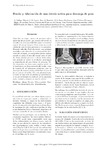Diseño y fabricación de una órtesis activa para descarga de peso

Use este enlace para citar
http://hdl.handle.net/2183/31499
Excepto si se señala otra cosa, la licencia del ítem se describe como Atribución-NoComercial-CompartirIgual 4.0 Internacional (CC BY-NC-SA 4.0)
https://creativecommons.org/licenses/by-nc-sa/4.0/deed.es
Colecciones
Metadatos
Mostrar el registro completo del ítemTítulo
Diseño y fabricación de una órtesis activa para descarga de pesoTítulo(s) alternativo(s)
Design and fabrication of an active orthosis for anckle weight reliefAutor(es)
Fecha
2022Cita bibliográfica
Gallego-Miguel, A., Garcia-Haro, J. M., Bautista, S., Simon Rodriguez, M. A., Velasco-Fernandez, A.I. (2022) Diseño y fabricación de una órtesis activa para descarga de peso. XLIII Jornadas de Automática: libro de actas, pp. 694-699. https://doi.org/10.17979/spudc.9788497498418.0694
Resumen
[Resumen] Cada día, un mayor número de personas sufren algún tipo de accidente, que termina derivando en una reducción de la movilidad de alguna extremidad o parte del cuerpo humano. Como consecuencia, la calidad de vida de estas personas se ve considerablemente reducida. Particularmente, una patología asociada a esta situación es la osteocondritis disecante del astrágalo, la cual produce fuertes dolores cuando se apoya el peso del cuerpo sobre el tobillo. Para intentar prevenir o aliviar dicho dolor, este artículo se centra en el diseño, prototipado y comprobación de una órtesis de descarga. Dicho dispositivo no tiene como objetivo asistir en el movimiento de flexo-extensión del tobillo, como la mayoría de las soluciones existentes, sino en descargar de manera axial y redistribuir el peso de forma externa al tobillo. Con este planteamiento, a través de una serie de pruebas y cuestionarios, se ha ido verificando la evolución de los pacientes antes, durante y después de usar la órtesis. [Abstract] Every day, a greater number of people suffer some type of accident, which ends up resulting in a reduction of the mobility of some limb or part of the human body. As a consequence, the quality of life of these people is considerably reduced. Particularly, a pathology associated with this situation is osteochondritis dissecans of the astragalus, which causes severe pain when the weight of the body is supported on the ankle. In an attempt to prevent or relieve such pain, this article focuses on the design, prototyping and testing of an unloading orthosis. This device does not aim to assist in the dorsiflexion ans plantarflexion movement of the ankle, as most existing solutions do. It pretends to offload axially and redistribute weight externally to the ankle. With this approach, through a series of tests and questionnaires, the evolution of the patients before, during and after using the orthosis has been verified.
Palabras clave
Ortesis
Osteocondritis disecante
Movilidad reducida
Rehabilitación
Orthosis
Osteochondritis dissecans
Astragalus
Reduced mobility
Rehabilitation
Osteocondritis disecante
Movilidad reducida
Rehabilitación
Orthosis
Osteochondritis dissecans
Astragalus
Reduced mobility
Rehabilitation
Versión del editor
Derechos
Atribución-NoComercial-CompartirIgual 4.0 Internacional (CC BY-NC-SA 4.0)
https://creativecommons.org/licenses/by-nc-sa/4.0/deed.es
ISBN
978-84-9749-841-8






